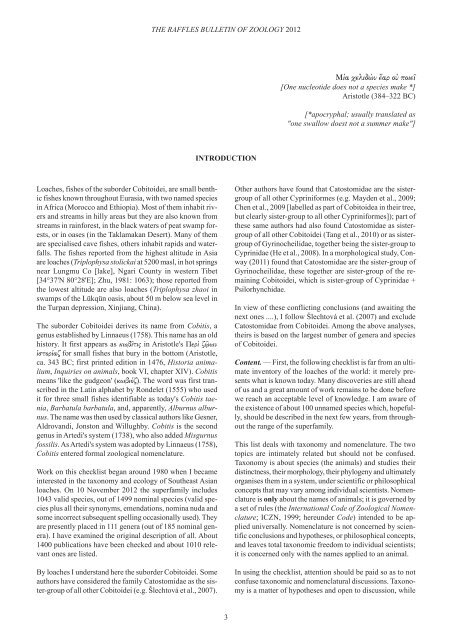Conspectus cobitidum - Raffles Museum of Biodiversity Research
Conspectus cobitidum - Raffles Museum of Biodiversity Research
Conspectus cobitidum - Raffles Museum of Biodiversity Research
Create successful ePaper yourself
Turn your PDF publications into a flip-book with our unique Google optimized e-Paper software.
Loaches, fishes <strong>of</strong> the suborder Cobitoidei, are small benthic<br />
fishes known throughout Eurasia, with two named species<br />
in Africa (Morocco and Ethiopia). Most <strong>of</strong> them inhabit rivers<br />
and streams in hilly areas but they are also known from<br />
streams in rainforest, in the black waters <strong>of</strong> peat swamp forests,<br />
or in oases (in the Taklamakan Desert). Many <strong>of</strong> them<br />
are specialised cave fishes, others inhabit rapids and waterfalls.<br />
The fishes reported from the highest altitude in Asia<br />
are loaches (Triplophysa stolickai at 5200 masl, in hot springs<br />
near Lungmu Co [lake], Ngari County in western Tibet<br />
[34°37'N 80°28'E]; Zhu, 1981: 1063); those reported from<br />
the lowest altitude are also loaches (Triplophysa zhaoi in<br />
swamps <strong>of</strong> the Lükqün oasis, about 50 m below sea level in<br />
the Turpan depression, Xinjiang, China).<br />
The suborder Cobitoidei derives its name from Cobitis, a<br />
genus established by Linnaeus (1758). This name has an old<br />
history. It first appears as κωβτις in Aristotle's Περ ζων<br />
στοραζ for small fishes that bury in the bottom (Aristotle,<br />
ca. 343 BC; first printed edition in 1476, Historia animalium,<br />
Inquiries on animals, book VI, chapter XIV). Cobitis<br />
means 'like the gudgeon' (κωβιζ). The word was first transcribed<br />
in the Latin alphabet by Rondelet (1555) who used<br />
it for three small fishes identifiable as today's Cobitis taenia,<br />
Barbatula barbatula, and, apparently, Alburnus alburnus.<br />
The name was then used by classical authors like Gesner,<br />
Aldrovandi, Jonston and Willughby. Cobitis is the second<br />
genus in Artedi's system (1738), who also added Misgurnus<br />
fossilis. As Artedi's system was adopted by Linnaeus (1758),<br />
Cobitis entered formal zoological nomenclature.<br />
Work on this checklist began around 1980 when I became<br />
interested in the taxonomy and ecology <strong>of</strong> Southeast Asian<br />
loaches. On 10 November 2012 the superfamily includes<br />
1043 valid species, out <strong>of</strong> 1499 nominal species (valid species<br />
plus all their synonyms, emendations, nomina nuda and<br />
some incorrect subsequent spelling occasionally used). They<br />
are presently placed in 111 genera (out <strong>of</strong> 185 nominal genera).<br />
I have examined the original description <strong>of</strong> all. About<br />
1400 publications have been checked and about 1010 relevant<br />
ones are listed.<br />
By loaches I understand here the suborder Cobitoidei. Some<br />
authors have considered the family Catostomidae as the sister-group<br />
<strong>of</strong> all other Cobitoidei (e.g. Šlechtová et al., 2007).<br />
THE RAFFLES BULLETIN OF ZOOLOGY 2012<br />
INTRODUCTION<br />
3<br />
Μα χελιδν αρ ο ποιε<br />
[One nucleotide does not a species make *]<br />
Aristotle (384–322 BC)<br />
[*apocryphal; usually translated as<br />
"one swallow doest not a summer make"]<br />
Other authors have found that Catostomidae are the sistergroup<br />
<strong>of</strong> all other Cypriniformes (e.g. Mayden et al., 2009;<br />
Chen et al., 2009 [labelled as part <strong>of</strong> Cobitoidea in their tree,<br />
but clearly sister-group to all other Cypriniformes]); part <strong>of</strong><br />
these same authors had also found Catostomidae as sistergroup<br />
<strong>of</strong> all other Cobitoidei (Tang et al., 2010) or as sistergroup<br />
<strong>of</strong> Gyrinocheilidae, together being the sister-group to<br />
Cyprinidae (He et al., 2008). In a morphological study, Conway<br />
(2011) found that Catostomidae are the sister-group <strong>of</strong><br />
Gyrinocheilidae, these together are sister-group <strong>of</strong> the remaining<br />
Cobitoidei, which is sister-group <strong>of</strong> Cyprinidae +<br />
Psilorhynchidae.<br />
In view <strong>of</strong> these conflicting conclusions (and awaiting the<br />
next ones ....), I follow Šlechtová et al. (2007) and exclude<br />
Catostomidae from Cobitoidei. Among the above analyses,<br />
theirs is based on the largest number <strong>of</strong> genera and species<br />
<strong>of</strong> Cobitoidei.<br />
Content. — First, the following checklist is far from an ultimate<br />
inventory <strong>of</strong> the loaches <strong>of</strong> the world: it merely presents<br />
what is known today. Many discoveries are still ahead<br />
<strong>of</strong> us and a great amount <strong>of</strong> work remains to be done before<br />
we reach an acceptable level <strong>of</strong> knowledge. I am aware <strong>of</strong><br />
the existence <strong>of</strong> about 100 unnamed species which, hopefully,<br />
should be described in the next few years, from throughout<br />
the range <strong>of</strong> the superfamily.<br />
This list deals with taxonomy and nomenclature. The two<br />
topics are intimately related but should not be confused.<br />
Taxonomy is about species (the animals) and studies their<br />
distinctness, their morphology, their phylogeny and ultimately<br />
organises them in a system, under scientific or philosophical<br />
concepts that may vary among individual scientists. Nomenclature<br />
is only about the names <strong>of</strong> animals; it is governed by<br />
a set <strong>of</strong> rules (the International Code <strong>of</strong> Zoological Nomenclature;<br />
ICZN, 1999; hereunder Code) intended to be applied<br />
universally. Nomenclature is not concerned by scientific<br />
conclusions and hypotheses, or philosophical concepts,<br />
and leaves total taxonomic freedom to individual scientists;<br />
it is concerned only with the names applied to an animal.<br />
In using the checklist, attention should be paid so as to not<br />
confuse taxonomic and nomenclatural discussions. Taxonomy<br />
is a matter <strong>of</strong> hypotheses and open to discussion, while

















